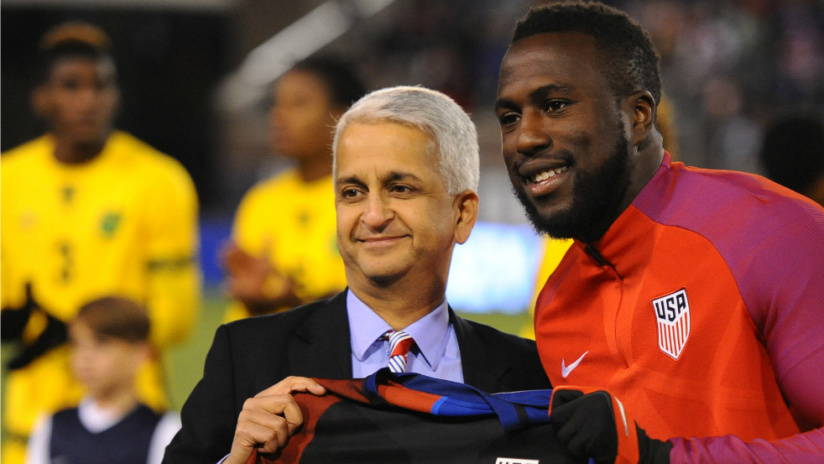US Soccer president Sunil Gulati addressed what’s next for the US men’s national team following their failure to qualify for next summer’s World Cup in a conference call with reporters on Friday, running down a laundry list of areas the federation feels it can improve as it moves forward.
Player development, the pay-to-play model and the structure of US Soccer’s leadership were the most talked about topics, though specific ideas for improvements were scarce. Gulati repeatedly said that the federation would examine their processes on the technical and administrative side, but was hesitant to dive into exactly what types of changes he’d like to make before US Soccer conducts a broader review.
Of the items discussed, youth development was brought up most frequently. Though US Soccer’s Development Academy has grown in both size and quality since it was established in 2007, it’s still in its infancy in terms of producing stars for the men’s national team.
Of the players who played on Tuesday at Trinidad, only three – starters DeAndre Yedlin and Paul Arriola and substitute Kellyn Acosta – came through the Development Academy system. Further, only five of the 14 players that saw action – Yedlin, Jozy Altidore, Bobby Wood, Jorge Villafana and Darlington Nagbe – are in the 23-28 age range, the usual time for players to be entering or in their primes.
That’s a hole in the USMNT pool. If more like that develop, it could be difficult for the program to improve more than incrementally.
“I’m not sure I’d identify one reason or say that the pipeline has dried up,” Gulati said. “You look at the players that are in the pipeline now and maybe they’re a little bit younger, some of the ones that people know quite a bit about, whether it’s Christian [Pulisic] or Weston [McKennie] or Matt Miazga or [Cameron] Carter-Vickers. Clearly, we didn’t qualify for [the past] two Olympics and that perhaps left a gap of a few years of players who had a lot of experience and might’ve been able to help us in [qualifying], but I don’t think I can point to one single thing. If we could, then we would try to rectify that one point.
“I think it’s any number of things, but I’m not going to prejudge that. We’re going to see what’s gone wrong, what we can do better and what needs to be completely overhauled.”
Gulati also spoke about the pay-to-play model in youth soccer, in which the costs of playing at many clubs can prevent lower-income players from competing. Scholarships are available to help families afford the cost of many clubs and every MLS academy except one is completely free for players, but making youth soccer more affordable could help fewer talented players slip through the cracks.
Of course, youth soccer is a long-established industry in the US. Making things cheaper won’t happen overnight, something Gulati made sure to note on Friday.
“It would be great to say no one playing soccer, recreationally competitive soccer will pay anything," he said. "That’s not going to happen in the current environment. And by the way, it doesn’t happen in most countries that players pay nothing. That’s a misnomer. What we have to do is make sure players aren’t prohibited from playing, but if you can afford it, you pay for it – you pay for it whether it’s a piano lesson or soccer.
“Our resources and those resources of the leagues and so on would be greatly taxed if you said we’re not going to have any pay-to-play models, but what you want is, as things become more expensive where there is a roadblock, you’d like to do something about that. MLS through its programs, the [US Soccer] academy program through its scholarship programs, has done that at one level, but we need to go deeper.”
The idea that US Soccer needs to hire a full-time technical director or general manager to oversee player development and coaching hires was advanced by several reporters this week. Former USMNT manager Jurgen Klinsmann served as technical director during his stint with the federation, but that position has been vacant since his dismissal last November. Ex-US international and US Under-20 head coach Tab Ramos is also USSF’s youth technical director, but doesn’t have any responsibilities at the senior level.
Gulati was asked about the idea of creating that sort of role on Friday, as well as the possibility of the US Soccer presidency becoming a paid position (it’s currently a volunteer role). He said he was open to both ideas, but, like most of the other potential changes discussed during his conference call, was noncommittal pending a broad review.
“We have looked at some of those things and we continue to look at those,” he said. “We went through quite a major review of our governance two years ago with outside help from [consulting firm] McKinsey, and then we went through quite an extensive review of leadership in our staff. We continue to do those things. And we didn’t think it was major lapses in those areas, but we wanted to get better. …So we will look at all of those things again. Whether it’s additional resources in the technical area, whether it’s the compensation structure of staff, all of those things. We don’t have anything perfect here, for sure.”













